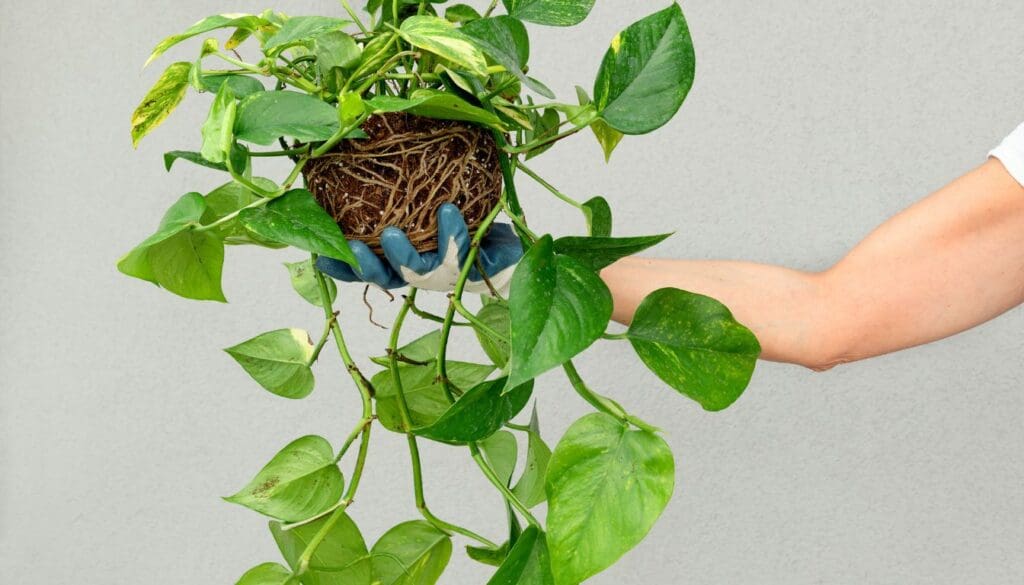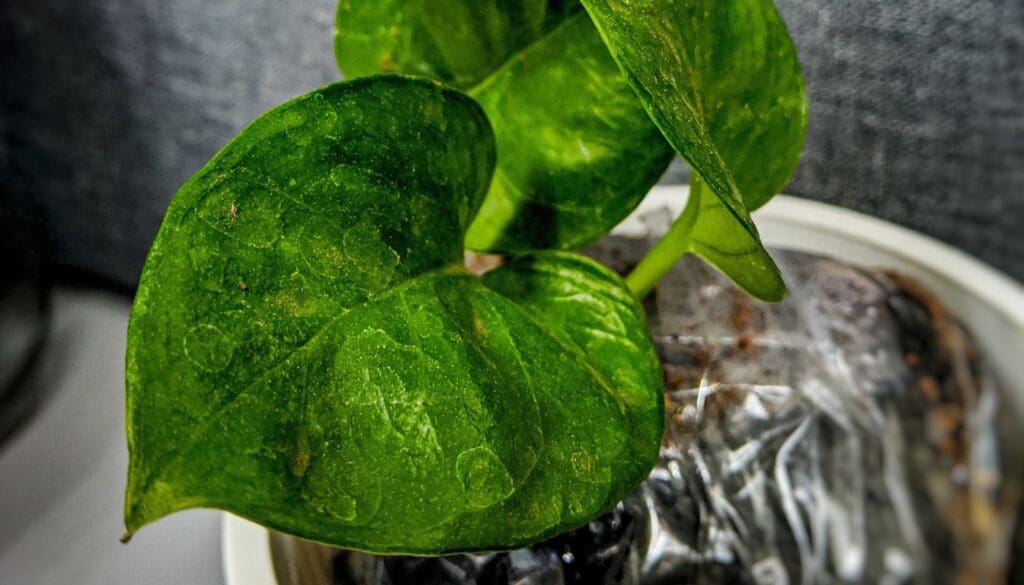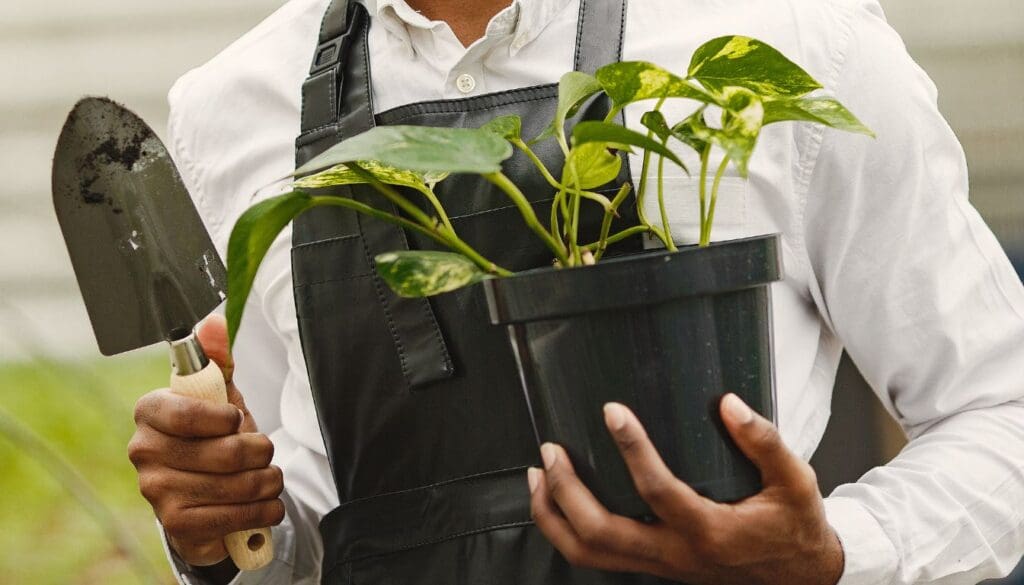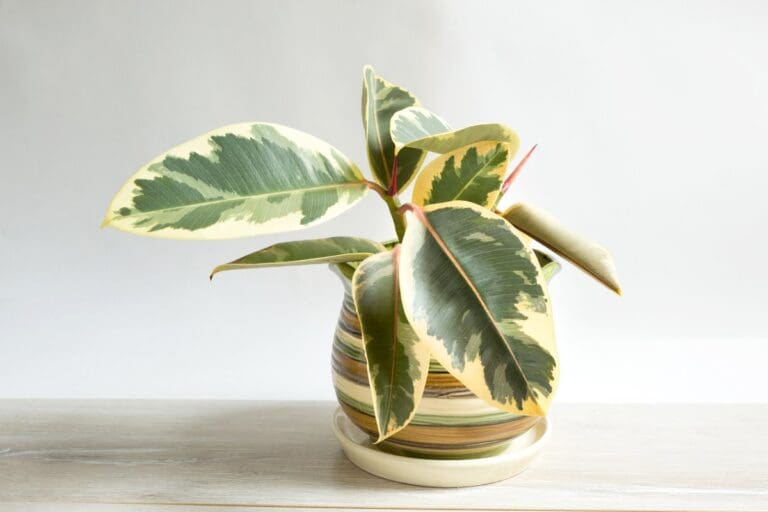Your Pothos Not Growing? 10 Reasons Why
Pothos are fast growers and require significantly less maintenance. If you’ve observed your Pothos slowing down or ceasing growth, you’re not alone. In my 12 years of gardening, I discovered various reasons for my pothos not growing.
Pothos are not growing due to dormancy, incorrect watering, poor soil, inadequate light, rootbound, temperature stress, nutrient deficiency, pests, and transplant shock. Addressing these issues is crucial for healthy growth.
Read this article until the end for a closer look at the reasons stopping your Pothos from growing and what you can do about it to regain its growth rate and vigor.

Please note: Simplify Plants is reader-supported. As an Amazon Associate, I earn from qualifying purchases made by our readers with no extra cost added to you all! Some links in the post are affiliate links and I get a commission from purchases made through links in the post.
1. Inadequate Light Affecting Pothos Growth
Inadequate or excessive light levels can stop Pothos from growing.
Generally, these plants are accustomed to growing in low lights shaded by forest canopies.
Hence, they need bright, indirect sunlight.
Pothos prefer a light intensity of around 75 to 200 footcandles.
Season, local climate, and weather can affect the light intensity.
Pothos grow faster when exposed to natural light, but excessive sunlight can stress the plant and reduce its growth.
You will also notice yellowing or brown scorch marks, indicating sunburns.
On the other hand, Pothos won’t thrive and grow without adequate sunlight.
While Pothos tolerate low light, no light will stop their growth.
They cannot perform photosynthesis or generate energy for growing new leaves and stems.
Find bright locations to encourage pothos growth
If your Pothos is not growing, check the light conditions for Pothos.
Shift your plant to a location that receives dappled sunlight, or put up sheer curtains or Venetian blinds in the windows providing direct sunlight (primarily, south and west-facing windows).
If your Pothos is in a dark corner, shift it to a bright location or use artificial Grow lights.
While shifting your Pothos for light, make sure you acclimate it.
Otherwise, it might receive burns.
An east-facing window can provide very gentle sunlight throughout the day.
You don’t have to use filters or worry about low lights.
2. Incorrect Watering Stunting Pothos Growth
Improper watering habits in Pothos are another reason behind the plant not growing.
Pothos need their soil to be moist, neither too dry nor water-soaked.
Before every watering session, the soil’s top 2-4 inches should be dry but moist below that.
When Pothos are overwatering, excessive moisture stays stagnant in the soil and around the roots.
Roots get deprived of oxygen, can’t breathe, and fail to transfer moisture and nutrients to the other plant parts.
As a result, the plant stops growing, and leaves lose their color and fall off.
If you don’t fix the problem, you might get root rot.
At this time, your plant will not only stop growing but end up dying.
On the other hand, underwatering keeps the roots dehydrated for prolonged periods.
The plant struggles to absorb the moisture and nutrients and, hence, stops growing over time.
Another issue is inconsistent watering, where irregular watering makes the soil cycle between bone-dry and oversaturated conditions.
The plant stops growing out of stress.

Watering tips and moisture level for Pothos growth
Identify what wrong you have done while watering Pothos, fix it, and then improve your watering habits.
Here’s what you need to do:
- If you have overwatered, check the soil. If it feels wet, stop watering and let it dry.
- Check the roots and see if there’s any root rot. If there is, remove the brown and mushy roots, spray some fungicide, and repot your Pothos with a new soil mix in a new pot.
- If you have not watered your Pothos for too long, start watering. Consider bottom watering if the soil does not absorb moisture through top watering.
- To improve your watering habits, always check the moisture level once a week and water the plant whenever the top few inches feel dry. You can set a watering schedule once you know how often your plant needs water.
I water my Pothos every 5-7 days during the spring and summer and reduce the frequency to every 7-15 days during the fall and winter.
Despite following a routine, I always check the moisture level before watering.
It helps me reduce the chances of watering problems.
3. Poor Soil Hindering Pothos Development
Your Pothos will stop growing even if you have corrected your watering habits. The reason is poor soil quality.
Pothos love well-drained, fertile soil to thrive.
If the soil has poor drainage, water stays stagnant in the soil.
This further suffocates the roots, hinders nutrient and moisture uptake, and stops the plant’s growth.
After recent repotting, you cannot fertilize your plant.
At that time, Pothos will receive nutrients from the soil.
If the soil is infertile, the plant won’t receive the necessary nutrients and stop growing.
Sometimes, improper pH levels can also stop Pothos from growing because it can imbalance the nutrient level.
Pothos potting mix quality
Make sure the Pothos potting mix is well-drained and fertile.
An ideal soil mix is 2 parts peat, 1 part perlite, and 1 part pine bark fines.
If Pothos soil is not draining moisture, add perlite or vermiculite to improve drainage.
For nutrition, add organic matter like compost.
If the soil mix is correct, check the pH level with a pH tester.
Use lime to raise the pH or sulfur to lower it.
Please go through our Pothos Soil article to learn more about soil recipes.
4. Rootbound Conditions Restricting Pothos Growth
When Pothos get rootbound, the roots grow in a circular motion and become highly compact.
When the roots bind together so compactly, they struggle to pass the nutrients and moisture to the other plants and stop growing.
Rootbound plants also stress the roots, making them unhealthy and susceptible to pests and diseases.

Repotting Pothos to Encourage Growth
One of the easiest ways to identify that Pothos has stopped growing due to rootbound is when roots grow out of the drainage holes, from the soil surfaces, and the pot edges.
When you see these signs, it is time to repot Pothos.
While repotting, choose a pot 1-2 inches bigger than the old one.
Pothos can grow quite faster, Repot your Pothos every 1-2 years during the spring or summer.
Take good care of your Pothos after repotting to help it recover from repotting stress by providing adequate light, water, warm temperature, and humidity.
Avoid feeding until you notice new growth.
5. Nutrient Deficiency Limiting Pothos Growth
Pothos not growing could be a sign of a lack of nutrients.
Pothos plants are not heavy feeders, but that doesn’t mean they don’t need to be fertilized.
Pothos requires a low amount of around 17 nutrients.
Lack of these nutrients will reduce the plant’s ability to perform well and produce new roots, stems, and leaves.
Most of the time, nitrogen deficiency is the cause of slow or stunted growth in Pothos because that’s what helps in the growth of leaves and vines.
Start fertilizing and follow a proper fertilization schedule for Pothos
If your Pothos isn’t growing, remember when you have fertilized it last.
If it’s been a long time, it is time to feed your plant.
For a quick dose, fertilize Pothos with a balanced liquid fertilizer.
Once you find new growth, you can continue with the liquid fertilizer every 4-6 weeks during the spring and summer.
For slow-release, apply 1-2 times a year during the active months.
It is good to dilute your fertilizer to half the recommended strength to avoid overfertilization.
Also, avoid winter feeding.
6. Temperature Stress Impeding Pothos Growth
Temperature can influence the growth rate of Pothos as it influences photosynthesis and respiration rates.
Pothos stop growing when the temperature drops below 55°F or above 90°F.
In colder temperatures, Pothos can’t perform photosynthesis, hindering sugar and starch production necessary for growth.
Thus, it will stop growing.
On the other hand, the respiration rate increases during hot temperatures.
As a result, the plant cannot perform photosynthesis to make energy, fails to compensate for the increased respiration, and stops growing.
Optimal temperature conditions for Pothos
If your Pothos is not growing and temperature seems to be the issue, protect it.
Pothos prefers temperatures between 65°F and 90°F.
If the room temperature goes below 50°F, transfer Pothos to a warmer location or use heat lamps.
Move it away from drafty doors and windows.
You can keep it in a room with a heating unit, provided Pothos is 12 ft. away from it and the temperature is set within 65-85°F.
When room temperature exceeds 90°F, move it away from areas receiving hot drafts and shift it to a cool room.
You can move Pothos to an AC room, 12 ft. away from the unit and the temperature doesn’t go below 65°F.
It is primarily needed for USDA zones 6-12.
Protect your Pothos more often from direct sunlight and water for hydration.
7. Pests Interfering with Pothos Growth

Pothos rarely encounter pests.
But if conditions are favorable, bugs will reach your Pothos, for example, prolonged wet or dry conditions, high humidity, lack of airflow, or overfeeding.
Pests, when present in large numbers, consume the plant sap containing nutrients and moisture.
It leads to severe dehydration of your Pothos.
Over time, the plant will get stressed and stop growing.
You will also notice yellowing, defoliation, and distorted leaves.
Common pests are aphids, spider mites, mealybugs, and scale insects.
If you suspect an infestation, check the underside of the leaves and stems.
You will notice them moving around and staying in groups.
Troubleshooting Pothos pests to make the plant grow again
- Isolate your Pothos and remove the heavily infected leaves.
- Spray neem or any other horticultural oil on the affected areas.
- Wipe down the leaves and vines with a cotton ball dipped in rubbing alcohol.
- Release natural predators like ladybugs and lacewings.
- If the infestation is large, use insecticides and pesticides containing pyrethrins and imidacloprid.
Keep an eye on your Pothos and check for signs of recovery.
Don’t stress further and provide all the requirements correctly.
8. Lack of pruning leads to sluggish growth in pothos
Pothos are very fast-growing plants. Pruning helps them grow faster and become bushier over time.
Pruning stimulates new growth in Pothos and directs it towards the healthy areas of the plant.
While pruning, you can remove the dead and damaged foliage and improve the plant’s tidiness and look. Pruning also increases airflow.
Without pruning, your Pothos won’t have any new growth or be bushy or shiny.
Pothos pruning and maintenance to encourage new growth
If your Pothos has overgrown and has stopped growing, consider pruning it.
Prune your Pothos during the growing season every 2-3 months whenever the plant seems overgrowing.
While pruning, cut the stem 1 inch below the leaf node.
That’s the place where new leaves will come out.
Don’t go too far down or up.
Prune the discolored and damaged leaves, some unwanted growth, for example, longer stems, and areas where you want bushy growth.
You can discard these cuttings or use them for soil or water propagation.
9. Transplant Shock Delaying Pothos Growth

If your Pothos shows no growth after repotting, it may be experiencing transplant shock.
Pothos repotting is not a very smooth phase.
The plant’s growth and development get disturbed, and it has to undergo several stressful steps.
Hence, it will stop growing until it adjusts to the new environment.
Adjustment after repotting
Keep caring for your Pothos and avoid further stress to overcome the repotting effects in it.
After repotting:
- Take care of your Pothos by providing dappled sunlight
- Water Pothos whenever the top few inches of the soil have dried.
- Provide 50-60% humidity.
- Protect from drafts and extreme temperatures.
- Avoid feeding until you notice new growth.
To reduce repotting shock:
- Use the same soil mix as you have used earlier.
- Don’t change Pothos’s position.
- Don’t fertilize until you see new growth.
10. Dormancy Slowing Pothos Growth
Pothos thrive in warm temperatures, ideally between 65°F and 90°F, as they originate from tropical regions.
During the winter, when the temperature goes below 50-55°F, the plant’s metabolism will reduce and stop growing.
Pothos go dormant in winter and stop growing.
Instead, it focuses on the improvement of the internal structures.
Hence, there is nothing to do here except wait for the weather to warm up in spring.
Since Pothos won’t have any new growth, reduce watering frequency and don’t fertilize during dormancy.
Pothos care tips to speed up its growth rate.
- Pothos craves for bright indirect sunlight to stimulate growth. Let it have 10-12 hours of bright, dappled sunlight.
- Pothos likes to be consistently moist. Hence, water the plant whenever the top few inches have dried. Water more often in summer and less often in winter.
- Plant Pothos in well-drained fertile soil with a pH of 6.1-6.8.
- Pothos is a tropical plant that thrives best between 65°F and 90°F temperature ranges and 50-60% humidity levels.
- Provide the proper nutrients by fertilizing Pothos every 4-6 weeks with a balanced liquid fertilizer (10-10-10 or 20-20-20 NPK) and 1-2 times a year with a slow-release fertilizer during the spring and summer.
- Dust and mist your Pothos occasionally to let it breathe and receive the nutrients properly. Mist the leaves with water and dust them with a soft cloth once a week.
- Prune your Pothos every 2-3 months during the active months. It will encourage robust growth and make it bushy. You can either discard the cuttings or propagate them.
- Repot your Pothos every 1-2 years during the active months. Use a pot 1-2 inches bigger than the old one.
Final thoughts
Pothos can stop growing for various reasons. It is essential to find out what’s causing trouble to your plant and fix it soon to encourage the plant to grow again.
Common causes behind Pothos not growing are inadequate light conditions, improper watering, poor soil quality, rootbound, lack of nutrients, extreme temperature and drafts, pests, lack of pruning, and repotting stress.
If you are doing everything correctly and none of these issues have appeared in your Pothos, it could be winter dormancy. Pothos going dormant in winter is natural, and there is no solution. Keep good care of your Pothos and encourage it to grow faster by following my care tips.
Are Pothos slow-growers?
Pothos are fast-growing plants and can increase quickly if provided with the proper care tips. However, the variegated varieties are slow-growers.
Why is my Pothos taking so long to grow?
Generally, Pothos are fast growers. If your plant takes time to develop, you may have a variegated variety or are inconsistent with the care routine. Analyze and solve it soon to help stimulate its growth.
Reference: Pothos Wikipedia
Note: Some images in the articles are sourced from Reddit and Other Platforms For Reference Purpose.






